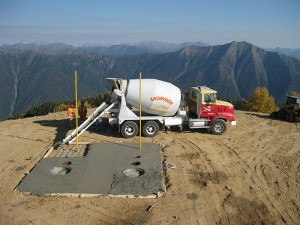Concrete
 Salvador Ready Mix Concrete takes pride in supplying traditional and specialty concrete that meets customers’ project requirements and industry specifications. In order to meet individual requirements, we have tailored mix designs that are unique to each project. We are capable of providing on-site testing or can recommend an independent testing facility for on-site slump and air tests or 28 day strength testing.
Salvador Ready Mix Concrete takes pride in supplying traditional and specialty concrete that meets customers’ project requirements and industry specifications. In order to meet individual requirements, we have tailored mix designs that are unique to each project. We are capable of providing on-site testing or can recommend an independent testing facility for on-site slump and air tests or 28 day strength testing.
- Salvador is a BC Ready-Mixed Concrete Association Certified Plant
- 60+ years of experience
- Consistently adapting to industry standard changes and the latest technologies
- Clean, well maintained equipment
- On-site quality control testing, in house or independent, available upon request
- On time, knowledgeable and friendly staff
Frequently Asked Questions About Concrete:
(click each question to view the answer)
Is all concrete the same?
No, different strengths of concrete are used for different purposes. For example, shop floor, exterior slabs, driveway would be 32 MPA 5-8% air to meet CSA specifications, footings and walls would be 25 MPA. Aggregate size and shape, as well as different admixtures, can also vary.
What is air-entrained concrete?
Because of our rapid freeze-thaw cycles, air is an important addition to concrete. Air-entrained concrete contains billions of microscopic air cells per cubic foot. These air pockets relieve internal pressure on the concrete as it freezes and thaws. Air-entrained concrete is produced by the introduction of air-entraining agents while batching, but can also be adjusted on-site. The amount of entrained air is usually between 4 percent and 8 percent of the volume of the concrete, but may be varied as required by special conditions.
If I increase the strength of concrete, will it reduce cracking?
No, all concrete is subject to cracking. Proper site preparation, first-rate finishing techniques, concrete that meets specifications, and proper curing techniques are all preventative measures but still will not guarantee no cracks.
Does Salvador Ready Mix finish the concrete?
No, we supply and deliver the concrete, but a concrete finisher would have to be hired by you to finish the concrete. We would be pleased to provide a few reputable referrals and more information.
Can I paint my concrete?
Yes, but it will likely flake off sooner than later. Check with your local hardware store for the most effective brand of paint.
What is the minimum amount of concrete I can order?
Salvador Ready Mix can deliver 0.8M³, anything under three metres will have the applicable minimum load charge applied.
Can it be too hot or too cold to place concrete?
Temperature extremes make it difficult to properly cure concrete. On hot days, too much water is lost by evaporation from newly placed concrete, making placing and finishing challenging, affecting the quality of the concrete. If the temperature drops too close to freezing, hydration slows to nearly a standstill. Under these conditions, concrete ceases to gain strength and other desirable properties. In general, the temperature of new concrete should not be allowed to fall below 50 Fahrenheit (10 Celsius) during the curing period.
What is the difference between cement and concrete?
Portland cements are hydraulic cements composed primarily of hydraulic calcium silicates that set and harden by reacting chemically with water. When the paste (cement, air, and water) is added to aggregates (sand and gravel, crushed stone) it acts as an adhesive and binds the aggregates together to form a stone like mass, concrete, the world’s most versatile and most widely used construction material.
What does MPA mean?
MPA is the metric unit for pressure, or stress, called megapascal. It refers to the compressive strength of concrete, the higher the MPA, the higher the strength. The strength of concrete varies depending on the cement content and the water cement ratio.
Why does concrete crack?
There are two main reasons that concrete cracks. The most common cause is shrinkage. Concrete changes slightly in volume when it cures, a chemical reaction called ‘hydration’. In typical concrete this change amounts to about 500 millionths. Translated into dimensions, this is about 1/16 of an inch in 10 feet. The reason that contractors put joints in concrete pavements and floors is to allow the concrete to crack in a neat, straight line at the joint when the volume of the concrete changes due to shrinkage. The other cause of cracks are usually related to improper site preparation, poor placing and finishing techniques, and/or poor curing techniques. A reputable and professional contractor is your best defense against unsightly cracks in your new concrete.
Why do concrete surfaces flake and spall?
Concrete surfaces can flake or spall for a number of reasons: In areas of the country that are subjected to freezing and thawing the concrete should be air-entrained to resist flaking and scaling of the surface. If air-entrained concrete is not used, there will be subsequent damage to the surface. The water/cement ratio should be as low as possible to improve durability of the surface. Too much water in the mix will produce a weaker, less durable concrete that will contribute to early flaking and spalling of the surface. The finishing operations should not begin until the water sheen on the surface is gone and excess bleed water on the surface has had a chance to evaporate. If this excess water is worked into the concrete because the finishing operations are begun too soon, the concrete on the surface will have too high a water content and will be weaker and less durable. Water should never be added to recently poured concrete to make finishing easier.
Does Salvador Ready Mix supply coloured concrete?
Yes, we can supply a vast array of colors. Call for more information, drop by the office or view the website at www.daviscolors.com
What are the decorative finishes that can be applied to concrete surfaces?
Colour may be added to concrete by adding pigments-before or after concrete is placed-and using white cement rather than conventional gray cement, by using chemical stains, or by exposing colorful aggregates at the surface. Textured finishes can vary from a smooth polish to the roughness of gravel. Geometric patterns can be scored, stamped, rolled, or inlaid into the concrete to resemble stone, brick or tile paving. Other interesting patterns are obtained by using divider strips (commonly redwood) to form panels of various sizes and shapes- rectangular, square, circular or diamond. Special techniques are available to make concrete slip-resistant and sparkling. Visit our Decorative Concrete page for more information.
How much does one cubic metre of concrete weigh?
One cubic metre of concrete weighs 2,300 to 2,400 kilograms.
How do you remove stains from concrete?
Stains can be removed from concrete with dry or mechanical methods, or by wet methods using chemical or water. Common dry methods include sandblasting, flame cleaning and shot blasting, grinding, scabbing, planing, and scouring. Steel-wire brushes should be used with care because they can leave metal particles on the surface that later may rust and stain the concrete. Wet methods involve the application of water or specific chemicals according to the nature of the stain. The chemical treatment either dissolves the staining substance so it can be blotted up from the surface of the concrete or bleaches the staining substance so it will not show.
Concrete vs. Asphalt, which is better?
Concrete is more durable, will last longer, and require less repairs. Provided your foundation, finishing, and curing is all done accordingly by a professional, a concrete driveway will withstand the test of time. Concrete also offers many creative opportunities such as colors, stamps, borders, patterns, and exposed aggregate. In winter, concrete driveways can suffer damage if you use the wrong de-icing product.
